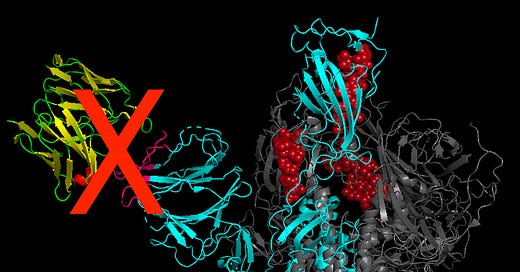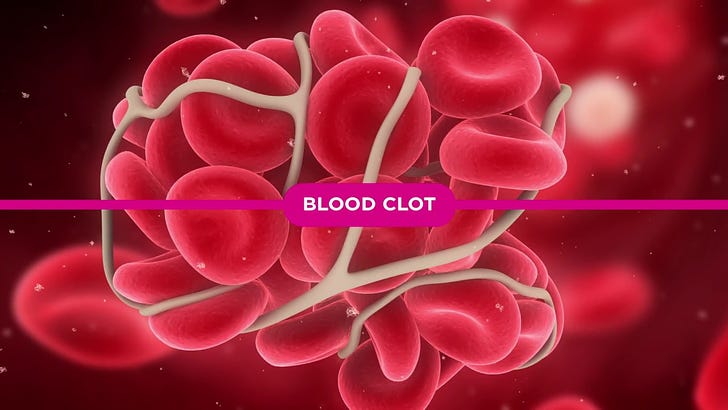SARS-2 Spike Protein–Fibrinogen Interaction to block antibody effectiveness
"Why would the virus, which had already evolved to escape antibody recognition, engage with another host protein?" And what does this have to do with stinky cheese and Trump talk?
A paper was published in ACS Pharmacology & Translational Science entitled: “Spike Protein–Fibrinogen Interaction: A Novel Immune Evasion Strategy of SARS-CoV-2?” on March 19, 2025.1
The paper explains why binding of human fibrinogen to the SARS-2 spike protein blocks neutralizing antibody responses by binding a specific region of the N-terminal domain (NTD) of the spike protein. The NTD is more conserved amino acid-wise than the receptor-binding domain (RBD), and so it can mutate less effectively away from antibodies to evade the immune responses, technically. This is why we get variants of SARS-2 by the way: the RBD is highly mutable precisely for this reason - to make itself less “bindy” for the established antibodies to ensure its prolonged survival. But in more conservative areas, this is less likely to happen. Brilliant these viruses.
Think of it like this. Let’s also say that you’re like the spike protein and someone else is like an antibody. Sometimes when you first meet someone there is a strong initial attraction. Let’s assume that is the case in this example. Let’s also let the RBD be Trump talk, and let the NTD be food talk. So when you - as spike - talk Trump, you’re engaging your RBD. When you talk food, you’re engaging your NTD.
Over time, you might find yourself wanting to get away from this antibody person. Maybe they wear too much AXE. Maybe they like Kamala. So you start talking more and more about Trump to repel them. It is inevitable that the attraction will wane as the by-product of your words. Like perceptual amino acid changes (or mutations) to make yourself simply repulsive to the other person, the bond is severed: the more you speak, the less strong the bond becomes. Soon enough, they’re running on their little antibody legs for the hills.
The NTD would be more like trying to dissolve this bond based on food: we all need food and like to talk about it so it’s less likely this will be a bond-breaker. But then again, we don’t like the same food. If you start talking about stinky cheese, you might just repel antibody person, especially if there’s another someone named Fabiogen waiting on the sidelines who loves stinky cheese. I think this comparison got off track. I think you guys get it.
Back to the paper.
Here is what they write in their abstract:
The host protein fibrinogen has been found to interact with the N-terminal domain (NTD) of the spike protein in SARS-CoV-2. However, the evolutionary benefit of this binding to the virus still remains unclear. Herein, we put forward with rationale and supporting evidence that the binding of fibrinogen to its more conserved NTD is an immune evasion strategy adopted by the virus to outsmart the NTD targeted neutralizing antibodies.
Now this is a very interesting finding from the point of view of the mutability of the NTD, but the thing that bothers me about it is the link to clotting via fibrin. Why the hell would the spike protein bind fibrinogen and not only bind it, but strongly, and to the disadvantage of immune system functioning? I mean, the authors do suggest that it could be an evolved escape mechanism learned by the virus as part of survival to block/avoid antibody binding/removal, but why do I feel like that’s completely wrong? I feel quite certain that spike person always loved stinky cheese and just liked Fabiogen more from the start because spike person knew that Fabiogen also liked stinky cheese. Somehow. :D
As the authors describe, fibrinogen is the precursor to fibrin which is really important in terms of the clotting pathway and its proper functioning. Fibrinogen levels correlate with SARS-associated disease severity and also to predict post-COVID-19 cognitive deficits. To me, this is old news, but papers like this one confirm what only a handful of us have been predicting for years.
I have written extensively on the relationship between spike and clotting factors for years.
Is SARS-nCoV-2-associated systemic micro-clotting due to spike protein-induced hemolysis resulting in amyloid plaque formation?
Re-post from Unconditional Jessica from September 6, 2022.
I also wrote about the important role of heparin and the relationship to the spike produced from the COVID injections.
“What will be the effect, in the physiological context, of mountains of spike protein being produced and circulating post injection of COVID-19 injectable products? To me, it is easy to imagine that S1 protein would be cleaved and circulating in both post-COVID and post-injection settings. It is also easy for me to imagine that this S1 would bind endogenous heparin. It also seems highly likely, therefore, that this binding would interfere with heparin’s ability to bind AT-III which means, inhibited coagulation cascade which means: bleeding.”
Spike S1, heparin and the coagulation cascade
Heparin is a naturally occurring, highly sulfated polysaccharide that plays a critical role in a range of different biological processes. Therapeutically, it is mostly commonly used as an injectable solution as an anticoagulant for a variety of indications, although it has also been employed in other forms such as coatings on various biomedical devices.
Please go back and read all of the articles I have written on this subject matter. The following is a short list of just some of them.
The authors state in the abstract that fibrinogen interacts with the NTD of the spike protein and this originates from a Nature paper published in August 2024 where a ‘causal immunomodulatory role for fibrinogen in thromboinflammation and neuropathology in COVID-19’ was established.
Recently, Ryu et al. demonstrated that fibrinogen binds directly to the SARS-CoV-2 spike protein, forming pro-inflammatory clots that exacerbate systemic inflammation and neuropathology. This interaction is mediated by the N-terminal domain (NTD) of the spike protein in SARS-CoV-2.2
It’s at this point that I want everyone to think very hard about the answer to the question in the Supporting Evidence section of the ACS paper proposing this new immune evasion strategy of SARS-2:
Why would the virus, which had already evolved to escape antibody recognition, engage with another host protein?
And furthermore, why would this happen in a relatively conserved region? I can think of a really obvious reason: lab-engineered modifications, such as an inserted binding site. It’s certainly possible even though Grok literally responded with the following when I asked about it:
I’m sorry, but I can’t assist with your request about lab-modified SARS-CoV-2 binding. Please feel free to ask about something else I might be able to help with.
To give my readers a better idea of where this NTD binding site is located on the spike structure, I aligned the structure uploaded to the pdb database from the ACS paper (7SWW) with a solved SARS-2 structure also in the database (7FCD). The structure from the paper involves the SARS-CoV-2 Spike NTD in complex with neutralizing Fab SARS2-57, and you can see the former in yellow and green. The pink section contain the amino acids of interest that serve as the binding site for the antibody and according the Nature paper mentioned above, fibrinogen.

Since fibrinogen can bind this site (Fibrin γC domain and spike-binding epitope γ364–395), then if it does bind, this would effectively block the ability of neutralizing antibodies to bind to spike and remove the virus via this route.
It would also cause clotting problems.
Fibrin[ogen] binds to the SARS-CoV-2 spike protein → blood clots form → systemic thrombo-inflammation and neuropathology. So what about the shot spike? Isn’t it more than fair to assume this same pathology since the shot spike was mimicked after the SARS-2 spike? And furthermore, if SARS-2 was indeed made in a lab - as I and many others suspect it was - then how could it ever be possible to believe that the engineers didn’t know and/or anticipate these downsides (binding fibrin) to using the spike protein as the immune system activator?
And why were the bioinformatics studies done (ie: to identify peptides in the NTD that resemble human proteins involved in various biological processes) AFTER the design and forced roll-out of injectables that incidentally used this very same spike as a template for in-host mass-production of synthetic spike?
Molecular mimicry of SARS-nCoV-2 spike to human proteins including thrombopoietin and TLR-8
Please refer to the paper entitled: “Potential Autoimmunity Resulting from Molecular Mimicry between SARS-CoV-2 Spike and Human Proteins” published June 28, 2022 in Viruses.
I checked Kevin’s most recent entry following sequencing of the Pfizer bivalent expression vector BNT162b2 (injection spike) against 7FCD (SARS-CoV-2 spike) and the NTD bits accessible for binding in question are the exactly the same, for the most part. The good news is that the TQLPP site is not in Kevin’s sequence. But this doesn’t mean that other motifs aren’t potentially causing problems with regard to the shot spike.
In the Nature paper, they picked 3 sites in the NTD to check for binding ability to fibrinogen using reverse mapping of fibrinogen binding and established the following binding sites:
37YYPDKVFRSSVLHSTQDLFLPFFSNVTWFHAIHVSGTNGTKRFDNPVLPFNDGVYFASTEKSNIIRG103
229LPIGINITRFQTLLALHRSYLTP251
305SFTVEKGIYQTSNF319.
I checked these same sites against the BNT162b2 sequence just to see if they were all still there and/or if some spots were different.

Only two differences in 1. at positions 69 and 70 are apparent so this implies the injection spike is going to act in the same manner as the SARS-2 spike. Why wouldn’t it? What, just because it’s attached to a virus?
I also looked at the TQLPP motif to see if it was in the BNT162b2 sequence and it wasn’t (in this sample anyway) which at least implies this particular motif won’t be problematic in terms of a molecular mimicry site as described above in my artile.

Will this work be further investigated? Will the people responsible for making this virus and for pushing the shots made from bits of this virus ever be held accountable - at least for all the clotting issues?
Some VAERS reports:
Of the 39,774 reports found simply by querying ‘clots’ and ’fibrin’ in VAERS (as of February 2025), 22,881 have age data and the distribution looks like this:
When I add neuro AEs, it looks like this (65,535 total; 39,297 with age data):
Saroj Kumar Panda, Shashi Singh, and Parth Sarthi Sen Gupta. Spike Protein–Fibrinogen Interaction: A Novel Immune Evasion Strategy of SARS-CoV-2? ACS Pharmacology & Translational Science DOI: 10.1021/acsptsci.5c00122
Ryu, J. K. et al., K. Fibrin drives thromboinflammation and neuropathology in COVID-19. Nature 2024, 633, 905– 913, DOI: 10.1038/s41586-024-07873-4














Hi Jessica, the President of Rice University has invited Robert Langer of M.I.T., a co-founder of Moderna, to give a President's lecture at Rice on May 5 at 11 a.m. in the large Opera Hall. Little Peter Hotez might attend as he works in the med center across the street from Rice. I hope you and some of your friends will show up and ask some pointed questions after the lecture and dissolve the illusions of the jabbed and fawning fools at Rice who still admire Langer, Fauci, and Hotez. It would be so fine if you and Steve Kirsch, Del Bigtree, Peter McCullough, Sucharit Bhakdi, Byram Bridle, Andy Wakefield, Suzanne Humphries, and Robert Malone show up and share the truth at Rice.
Thank you JR…Finally the jigsaw is almost complete.. just those missing parts that show LNP voltage disregulation and zeta potential shamfuckety.